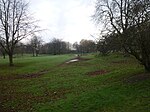Thurlby, South Kesteven
Civil parishes in LincolnshireSouth Kesteven DistrictUse British English from November 2014Villages in Lincolnshire

Thurlby is a village and civil parish in the South Kesteven district of Lincolnshire, England. It is situated just west of the A15 road, 2 miles (3 km) south from the town of Bourne, and on the edge of the Lincolnshire Fens. It is sometimes referred to as Thurlby by Bourne to distinguish it from other villages in Lincolnshire with the same name. Thurlby and the hamlet of Northorpe to its north are conjoined. The parish had a population of 2,136 at the 2001 census and 2,153 at the 2011 census.
Excerpt from the Wikipedia article Thurlby, South Kesteven (License: CC BY-SA 3.0, Authors, Images).Thurlby, South Kesteven
The Green, South Kesteven Thurlby
Geographical coordinates (GPS) Address Website Nearby Places Show on map
Geographical coordinates (GPS)
| Latitude | Longitude |
|---|---|
| N 52.738375 ° | E -0.378584 ° |
Address
Animates Veterinary Clinic
The Green 2
PE10 0EB South Kesteven, Thurlby
England, United Kingdom
Open on Google Maps








